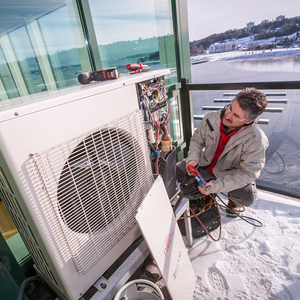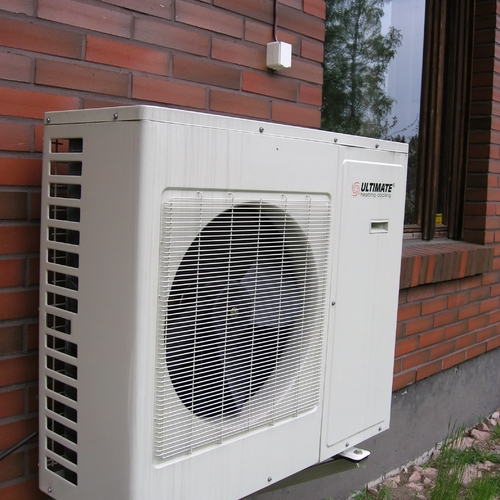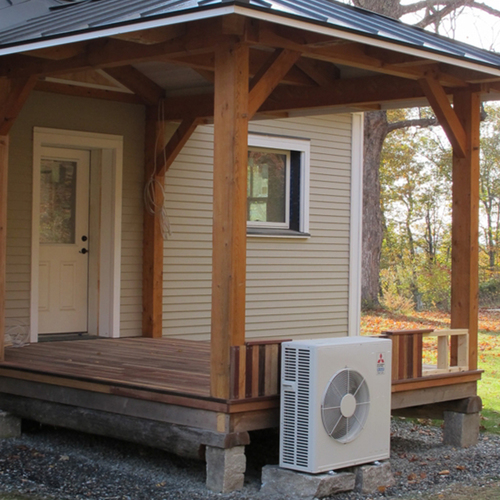
In the Canadian maritime province of Nova Scotia, a GBA reader named Janet is building a new weekend home whose heating system will include both a wood stove and radiant-floor heat powered by a ground-source heat pump.
The two-level, 2,000-square-foot house will consist of a walkout basement with two bedrooms, a bathroom, and a laundry room, plus an upper floor with a kitchen and living room and another bedroom and bath. The house will be well insulated: R-20 under the slab, R-34 basement walls, R-24 second-floor walls, and R-60 in the attic.
The first floor slab will be concrete, which Janet plans to heat with in-floor tubing. On the second floor, Janet will install a wood stove that she plans on using regularly when she’s there.
“We are unsure of what other heat, if any, we need to install on this level,” Janet writes in a Q&A post. “How much heat can we expect on the 2nd floor from the 1st level in-floor heat?”
Installing hydronic heat on the second floor — either in-floor tubing or baseboard radiators — seems like overkill because it won’t be used when the wood stove is running, she says.
Would a few baseboard electric units do the trick?
That’s the question for this Q&A Spotlight.
Ground-source heat is expensive
A ground-source heat pump (sometimes called a geothermal heating system) is the “most capital-intensive heating system imaginable,” Walter Ahlgrim tells Janet, and it will do little to make the second floor of the house comfortable.
“How many hours a day will you spend in the basement enjoying the warm floors?” he asks. “Or is that money better spent upstairs where you would benefit from it every day?”
Ahlgrim says that wood stoves and high-performance houses are rarely a good combination.
…
Weekly Newsletter
Get building science and energy efficiency advice, plus special offers, in your inbox.

This article is only available to GBA Prime Members
Sign up for a free trial and get instant access to this article as well as GBA’s complete library of premium articles and construction details.
Start Free TrialAlready a member? Log in















20 Comments
It seems to me that an awful lot of homebuilders wait until the very last possible moment before asking a question about their design plans. When people take the time to analyze the design, offer advice or suggest products or systems that will perform better, cost less and require less maintenance you find out that the homeowner has already started construction. A little late to be changing major building components. Still, Janet's house may be a wonderful lession to others of what not to do.
Nova Scotia resident here. Air source heat pumps work wonderfully in our climate.
I'm Janet, the house builder. I wanted to point out that I posted my initial question in July. The picture above was taken 10 days ago. Over the interval, we sought additional advice from an energy consultation company and worked out details with our "old-school" builder. Turns out he had many of the same suggestions posted by your experts and readers. I guess 30+ years of experience counts for something. We ended up modifying our construction plans substantially. When I was asked if we could be the focus of this "spot-light", I was not asked to provide any information on what plan changes, if any, we had made. Having no previous construction experience I greatly appreciate the helpful advice that we were given initially. However, I do not appreciate being a "lesson to others of what not to do" as implied in this article (and stated explicitly in the comment above). Yes, we have a terrific view, and I think we will also have a well built house.
Hey Janet, just an encouraging word to a fellow self builder (also with little mechanical design and construction knowledge...) Most of the folks on GBA will offer wonderful advice to folks like us in a wonderfully moderated forum. And once in a while, and this goes with many online forums, someone will drop a quick one line comment without any thought. Don't let the above comment bring you down. Also, after reading the article, I don't think you are being called out that way in the article. Your design is just not the way some folks would have done it for their taste and for their perspective on green building. Your goals can be different and your design can be different because you have to balance greenb building, with design, cost, labor, timeline, and your personal tolerance to all of the above . End of the day, you've got a well insulated house and that's a great starting point for any mechanical design. Best of luck on your build.
Janet,
I'm sorry if the Spotlight or some of the comments offended you. These columns summarize online discussions. If information is missing, it can't be part of the conversation. GBA readers who post comments and suggestions are almost always trying to be helpful, even though it may not seem that way. We're lucky that readers are willing to share their experiences here and hope the exchanges are useful to others facing similar situations.
Janet,
Well this is interesting. I thought I recognized the view. We have recently built a single story house just to the right of the image shown.
Ours is a slab on grade/frost wall construction. We installed a wall hung electric boiler to heat the in-floor radiant pipes. We also have a Rais woodstove. The radiant heat was installed to keep the house at roughly 12 degrees when we are not there. Otherwise the wood stove easily maintains a comfortable heat during the winter when we are there to feed it.
It is not a large house, approx. 1000 sq.ft. Cedar shingles with a 3/4" strapped air gap.
The only thing I would caution you about would be the use of rigid insulation an the exterior of the foundation. The area is home to carpenter ants that love to nest in the easily chewable foam.
Arthur
Arthur,
Small world, thanks for the advice! We were planning to use exterior foam and cover the above grade portions of the foundation with cement board. Maybe we should rethink this...
Janet
Yes, we are indeed fortunate to have the contributions of the readership. But after reading the above column and comments I would not want to be the one asking for advice around here. If people submitting themselves to this Spotlight scrutiny are treated like Janet has been treated, who would want to be subject of a Spotlight? And since we are, editorially, in the thinly veiled contempt mode, I would say this Spotlight has been poorly handled and edited.
Eric Chung
Janet,
Hopefully someone with more knowledge regarding the exterior insulation will come along shortly. It is just disappointing after one spends so much effort sealing your house and thinking you have this lovely R-value to keep you warm only to find out that those little buggers have carved large holes in it.
I would consider mineral wool insulation. It is water proof and insect resistant. So is Borate, in rigid insulation, but a bit nasty environmentally. Did I mention, I'm no expert.
I was looking across the pond a few weeks ago and wondering if that was to be the site of a new house. You must be the last available lot at the end of that road.
Arthur
Arthur,
Yes, we are in the last lot on that road. Where are you? We're putting a blueskin membrane on the below grade foundation, so we need something to protect it before backfilling. The exterior foam was going to serve that purpose, as well as increase the r value of course. I'll look into these other options...I'm not keen on ants.
Janet
Janet,
We are the last house at the end of the road. Out on the point. If you walk the trail around the point, our house is the one clad in Corten panels. The rusty one.
Arthur
I am going out there next week. I might have a walk over to look at the progress.
Response to Eric Chung (Comment #7),
There are advantages and disadvantages to seeking free advice on any web forum, including GBA. In my opinion, GBA is one of the most civilized and polite web forums out there, where the editorial policy emphasizes a focus on building science and avoidance of personal insults.
The advantage of posting questions here, of course, is the chance to enter into a robust debate on the merits and demerits of different construction approaches, in hopes that clarity emerges from the debate. I'm glad to hear that (at least initially) Janet (as she reported ) "greatly appreciates the helpful advice that we were given initially."
The disadvantage is that the debate can sometimes be blunt; I plead guilty myself to occasional bluntness. I'd like to extend my apologies to Janet if my bluntness caused any offense.
Scott Gibson is correct: all of us in the GBA community are trying -- sometimes skillfully, and sometimes clumsily -- to steer our readers to a good outcome, by warning about pitfalls and recommending optimal solutions. Most of the readers who post questions on our site are aware of the rough-and-tumble nature of the technical debates here, and jump in anyway. I certainly wish the best for Janet, and I hope that she learned something from the community members who offered advice here.
Martin,
I was not offended in the slightest by your comments (or any others) on my initial posting. What offended me was the inference here that I had not thought ahead and/or had ignored everyone's advice when in fact we incorporated many of the suggestions made. Your GBA site clearly provides an invaluable service.
Scott,
I would have no issues with a summary of the original online discussion and I appreciate that you cannot include content that you don't have access to. That being said, I felt that the article made assumptions that went beyond a summary.
Janet
Janet, I, too, extend apologies to you for any comments I made that have offended you. My comments really have more to do with the timing of this article's publication rather than in your actual build itself. When an article on this site features a new build and the homeowner asks some really great questions I (as I'm sure most of the readers on this site) start to think through all the information they've gathered from a lifetime of experience and look forward to trying to help. Then when I read that the project has already begun construction it causes me to think "Why did I even bother? It's too late now".
This has nothing to do with you Janet, and there's also nothing that the GBA writing team can do about that either. They get their questions when they get them, write the articles with the information they're given and publish when they can. Still, it is frustrating to realize that in most cases offering any advice or ideas to a homeownercomes too late to do any good.
However, you Janet, are to be commended for seeking out additional advice from an energy consultation company and your old school builder and then implementing their ideas. Too many people would have just sat back and waited to see if they get any response here and by the time they do it would definitely be too late to make changes.
I wish you the best of luck with your build.
Janet,
Our neighbours to the south have a couple of brands of treated-foam that are termite and carpenter-ant resistant. As far as I can see there are none available up here in Canada. We had a bad ant infestation in our own house, and I have dealt with three other structures that were quite compromised before they were eliminated. One perhaps not very palatable solution is to keep plantings back several feet from your foundation and regularly treat the area with insecticides.
Small world to find a nearby neighbour posting too huh?
Thanks for the apologies guys but let's get back to those ants!
We have lots of them in the woods of Wisconsin so a stainless steel mesh (any big box hardware store) about three feet wide is added at the bottom to discourage bugs. Usually nailed to the mud sill and wrapped out and upwards over the exterior foam and nailed again to outer strapping/furring strips. Keep in mind carpenter ants do not eat good wood or dry material. They follow paths of moisture as a habit and only love decaying material that is wet. Properly named as they help us carpenters find bad building practices.
Good luck, PK
Paul,
I know that's the conventional wisdom, but I've found carpenter ants in b0ne-dry foam. I think it mimics the rotten stumps they favour as nests here in the PNW. They seem to be happy to nest in dry, warm conditions as long as there is a source of moisture nearby they can forage from.
They are also not adverse to using a very circuitous route to their nest, bypassing any precautions you might have taken at the foundation level. One large colony I finally eliminated were using the coaxial cable that ran from a satellite-dish to the house roof as their main entry p0int.
Ah yes. I have witnessed exactly what Malcolm has seen.
Only months after having the foam installed we noticed the ants. There was no rotten wood, only the foam for them to nest in. There was also an area of the wall/ceiling where they entered at the only untrimmed dormer. They made there way up the walls and happily carved nests in the spray foam. One of our neighbors has recently replaced all the rigid foam under their roof, along with the roof because of carpenter ants. Although there was rot present in this instance.
Janet,
We have used your contractors for the foundation of our build. I would use them again. You are in good hands.
Arthur
Thanks Arthur - please say hello if you ever see us there!
Janet
Being in Nova Scotia, I'd look at Maritime Geothermal who are in New Brunswick. They have cold climate air source heat pumps, both air to air and air to water. We are building next summer in Bruce County, Ontario and we've settled on a2w - we'll see how it goes! Ecologix also manufactures cold climate heat pumps. I think a mini-split model may not have the output at the colder temperatures. I'm designing for -25C.
Log in or become a member to post a comment.
Sign up Log in